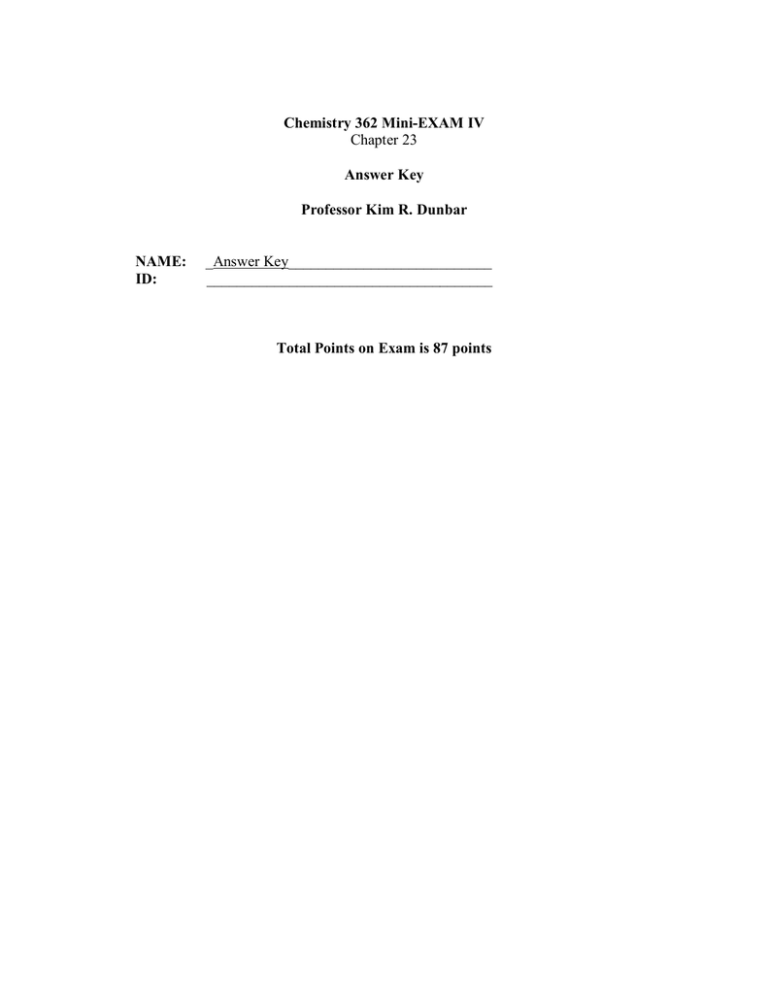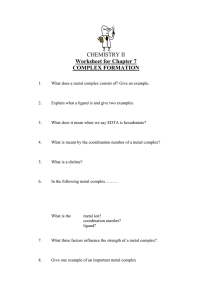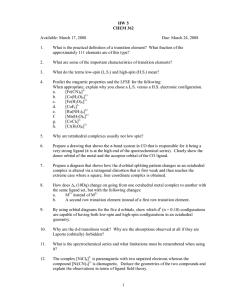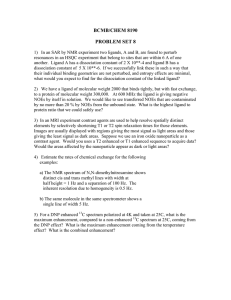Chapter 23 Chemistry 362 Mini-EXAM IV Answer Key
advertisement

Chemistry 362 Mini-EXAM IV Chapter 23 Answer Key Professor Kim R. Dunbar NAME: ID: _Answer Key___________________________ ______________________________________ Total Points on Exam is 87 points 1. (15 pts) a. What are the three main bonding theories for transition metal complexes and the two main considerations that all three theories must take into account? b. Briefly describe the main aspects of each approach. a. Crystal Field Theory (CFT), Ligand Field Theory (LFT), Molecular Orbital Theory (MO). All three must take into account the geometry of the complex and the type of ligand (i.e. πacceptor, σ-donor, π-donor). b. CFT is an elector static bonding model that treats the metals and ligands as point charges. The ligands are negative charges that are repelled by electrons in metal orbitals. This leads to the specific splitting patterns in the metal d orbitals. LFT is essentially the same as CFT but allows for covalency in the M-L bonds. MO is a comprehensive treatment of all interactions in the molecule. s, p and d orbitals on the metal are allowed to interact with ligand orbitals according to their symmetry. When this is done the HOMO and LUMO levels are the t2g and eg respectively. 2. (10 pts) In the Molecular Orbital diagrams of ML6 molecules, the transition metal always brings 9 orbitals into the M.O. diagram. Name them. dz2, dx2-y2, dxy, dxz, dyz, s, px, py, pz. 3. (12 pts) For the molecules in the list below, choose the correct answers from a-d. [Cr(CN)6]3a π-acceptor [MnCl6]4c π-donor 3+ [Fe(NH3)6] b σ-donor Mo(CO)6 a π-acceptor a. the ligand type is a π-acceptor. b. the ligand type is a σ-donor. c. the ligand type is a π-donor d. none of the above 2 4. (15 points) Sketch both a Low-Spin L.S. and a High-Spin H.S. d6 octahedral splitting diagram and put the electrons in. Calculate the LFSE for each one. The adoption of one configuration over the other depends on what? eg eg t2g Low Spin t2g High Spin Low Spin: 3(-2/5 Δo) + 3PE = -6/5 Δo + 3PE High Spin: 1(-2/5 Δo) + 4(3/5 Δo) + PE = 2Δo + PE The adoption of H.S. versus L.S. depends on the relative energies of Δo and PE. Δo depends on the ligand mainly. If Δo > PE → L.S. If Δo < PE → H.S. 5. (5 points) Why are all Tetrahedral transition metal complexes H.S. (High-Spin)? Δt is always smaller than PE. Therefore, tetrahedral complexes are high spin because the it costs more to pair the electrons than to place them in a higher energy orbital. 3 6. (20 points) Provide the missing information in the diagrams below: eg → dz2, dx2-dy2 Δo π-donor σ-donor t2g → dxz, dyz, dxy Ligand type = π-acceptor t2 → dxz, dyz, dxy Δt e → dz2, dx2-dy2 7. (10 points) Choose the two series from the four (A)- (D) below that are correctly shown for the effect they have on the d orbital splittings Metal dependence (A) Stronger Field (larger splittings) Lower field (smaller splittings) 2+ 2+ 2+ 2+ 2+ 3+ 3+ 3+ 3+ 4+ 3+ Mn < Ni < Co < Fe < V < Fe < Cr < V < Co < Mn < Mo < Rh3+< Pd4+< Ir3+< Re4+< Pt4+ (B) Lower field (smaller splittings) Stronger Field (larger splittings) Mn2+> Ni2+> Co2+>Fe2+> V2+>Fe3+>Cr3> V3+> Co3+ >Mn4+> Mo3+> Rh3+> Pd4+> Ir3+> Re4+> Pt4+ Ligand dependence - the Spectrochemical Series (C) Stronger Field (larger splittings) Lower field (smaller splittings) NO+ < CO, PF3 < CN- < NO2 < NH3 < H2O < OH- < F- < S2- < Cl- < Br- < I(D) Stronger field (larger splittings) Lower Field (smaller splittings) + NO > CO, PF3 > CN >NO2 > NH3 > H2O > OH- > F- > S2- > Cl- > Br- > I- 4





